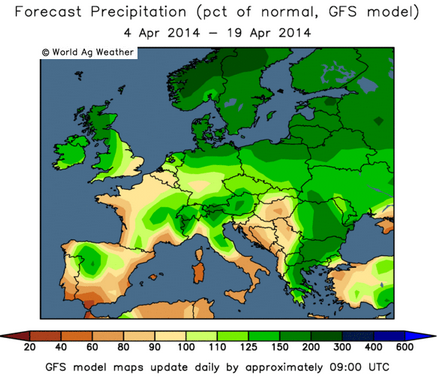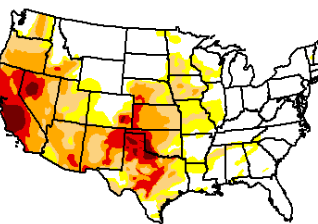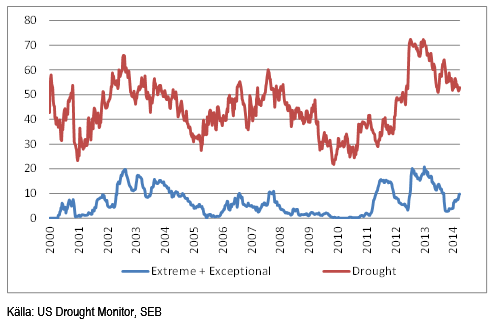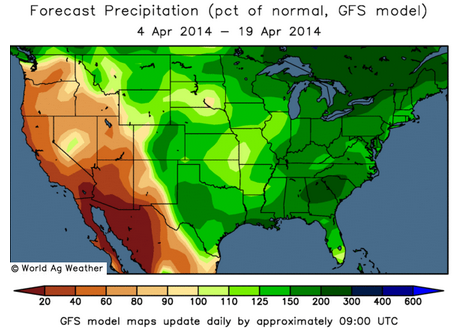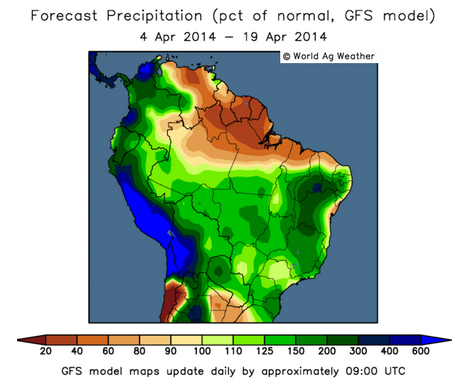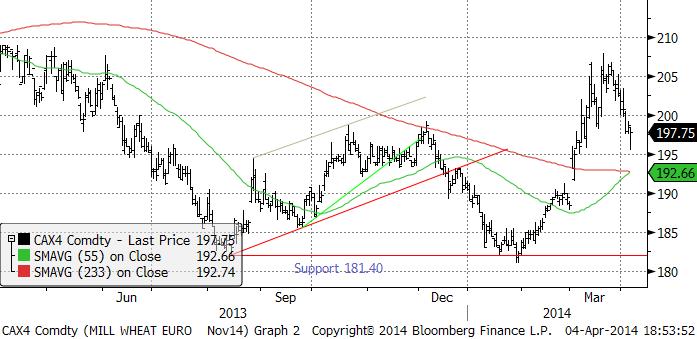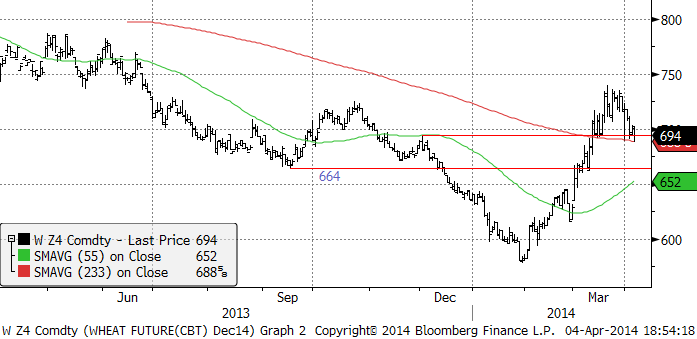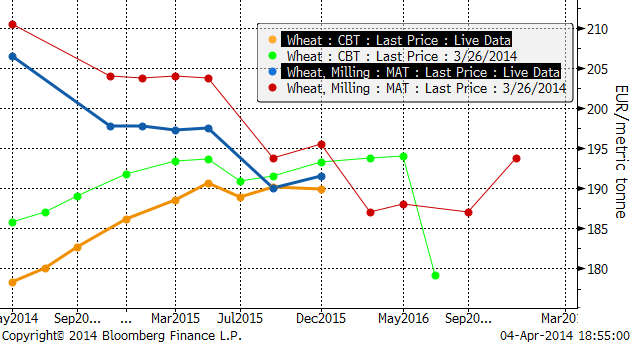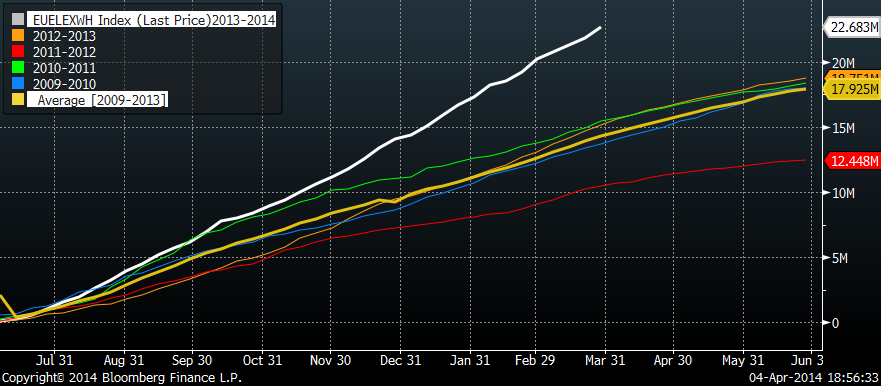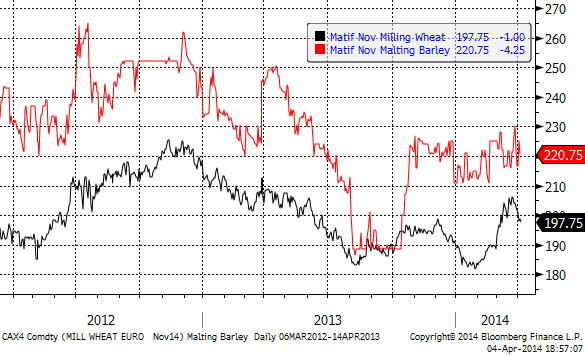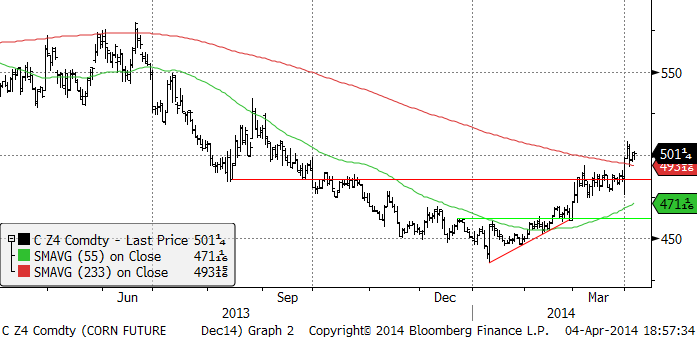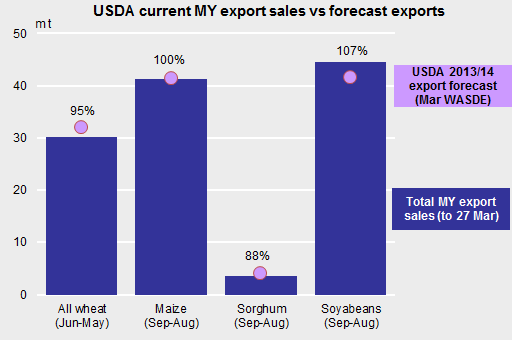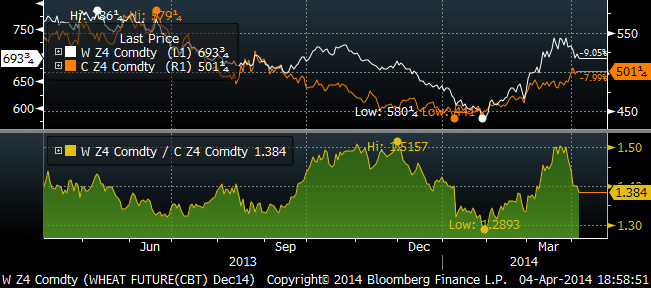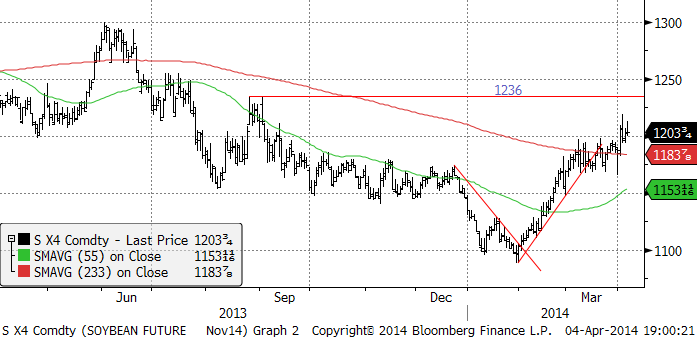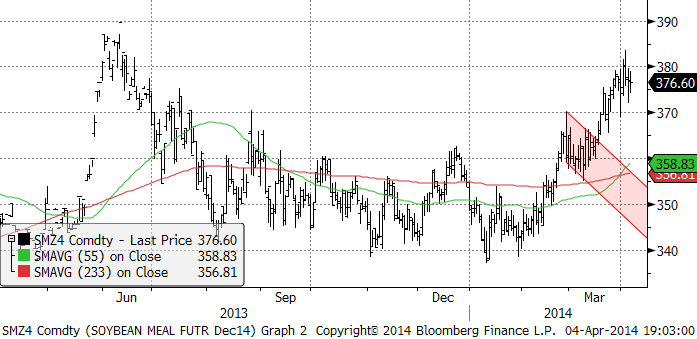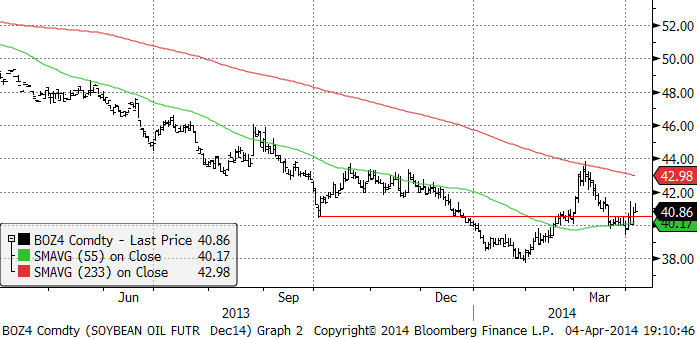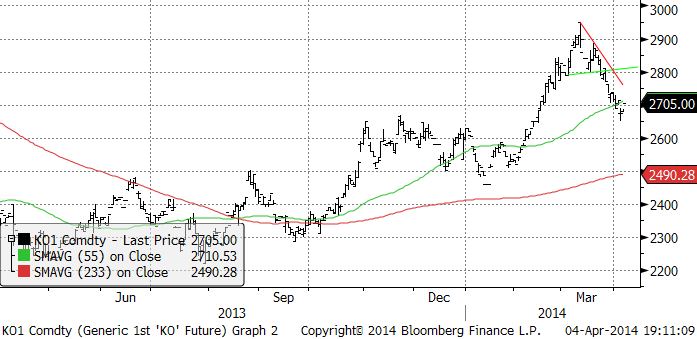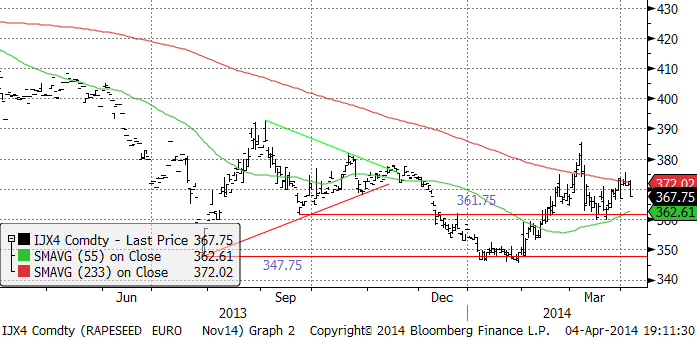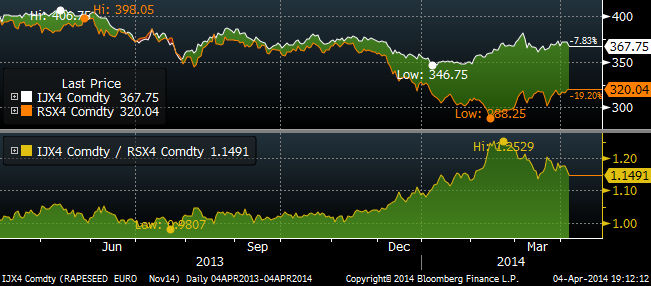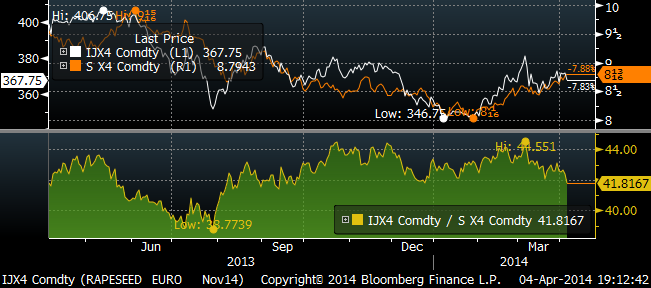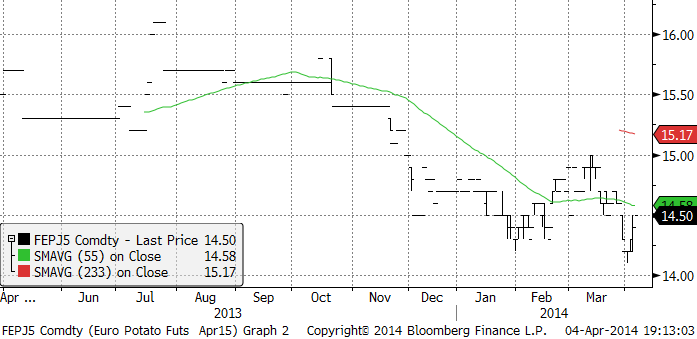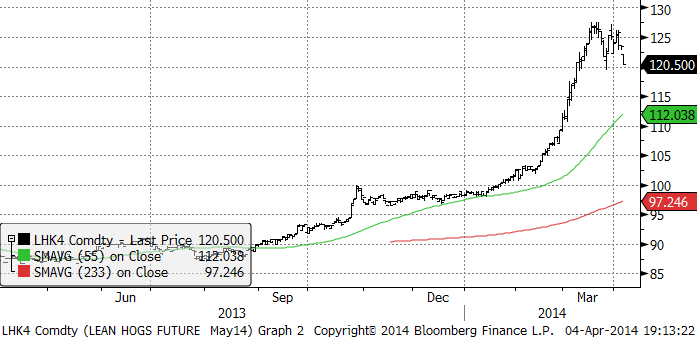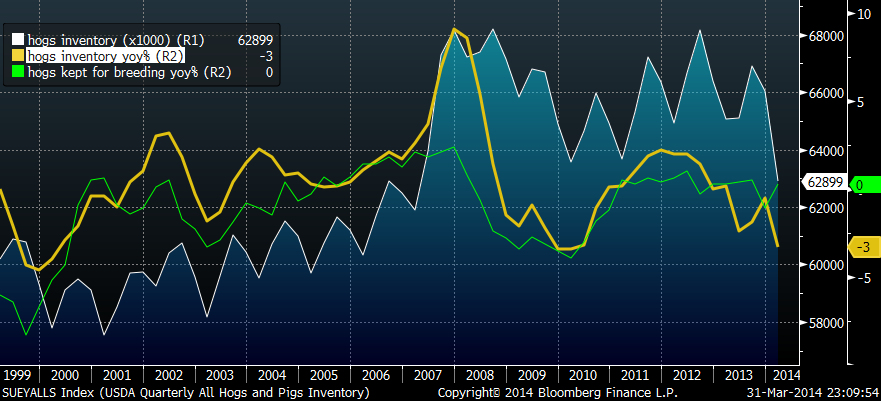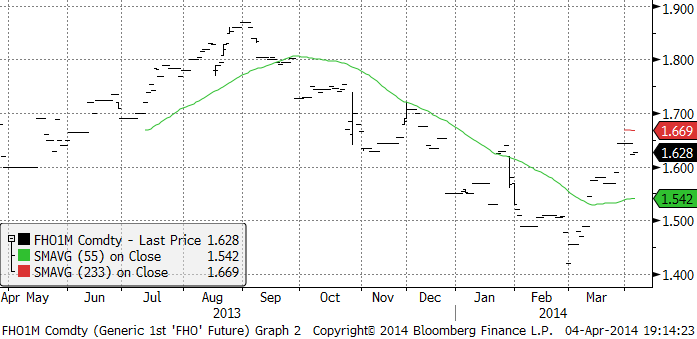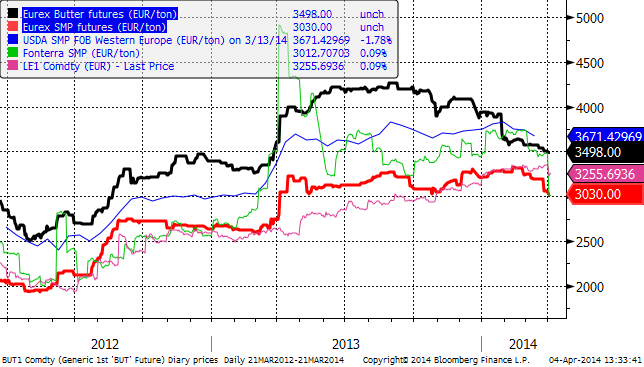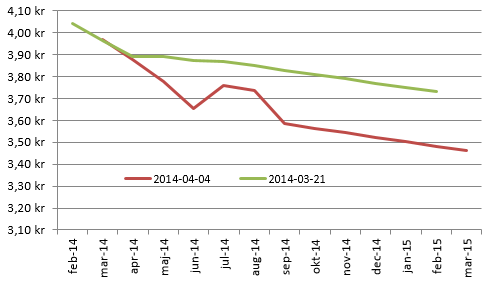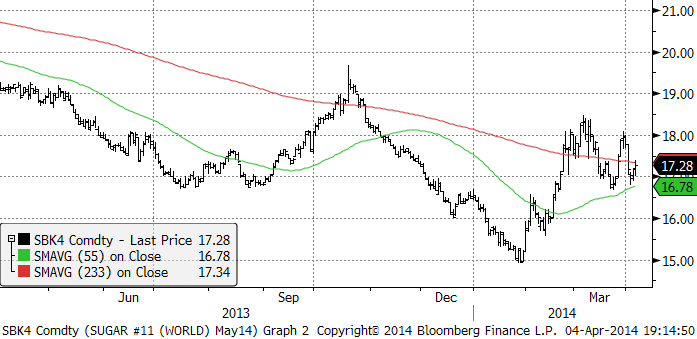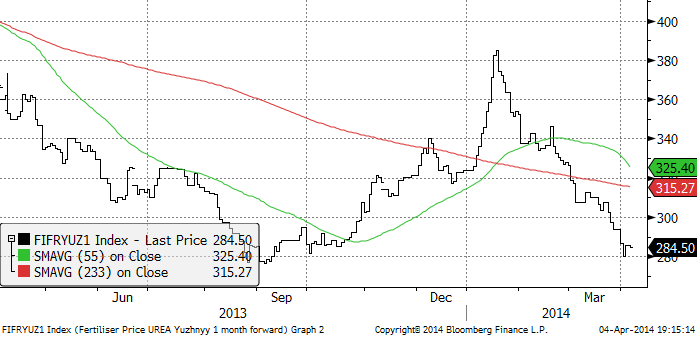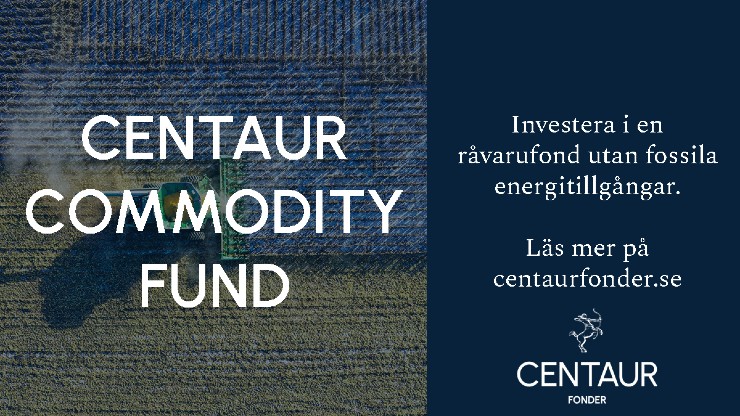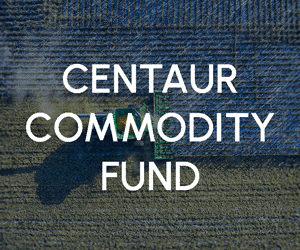Analys
SEB Jordbruksprodukter, 7 april 2014
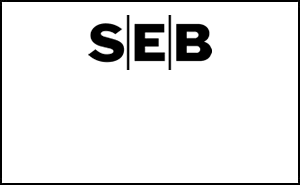

 USDA:s plantings-rapport präglade marknaden. Den ger stöd för spannmålspriset under marknadsföringsåret 2014/15. USDA:s Outlook Forum i slutet av februari förutspådde att produktionen nu kommer ifatt efterfrågeboomen, med stigande lager och fallande pris som följd. Platingsrapporten visar att detta skjuts upp åtminstone ett år.
USDA:s plantings-rapport präglade marknaden. Den ger stöd för spannmålspriset under marknadsföringsåret 2014/15. USDA:s Outlook Forum i slutet av februari förutspådde att produktionen nu kommer ifatt efterfrågeboomen, med stigande lager och fallande pris som följd. Platingsrapporten visar att detta skjuts upp åtminstone ett år.
De tre största majsexportörerna i världen, USA, Brasilien och Ukraina kan tillsammans få 30 mt lägre produktion i år än vad man trodde för några månader sedan. Torkan i USA:s veteområden innebär att USA inte kommer att producera lika mycket vete som förra året. Däremot ser det riktigt bra ut i EU med dels stora arealer höstsådd vete och raps och dels mycket gynnsamt väder.
USA:s torkdrabbade veteområden fick regn i veckan som gick och prognosen innehåller ännu mer regn, vilket fick vetepriset att falla tillbaka från de högsta nivåerna. Oron för en eskalering av krisen i Ukraina har avtagit markant, vilket även det bidragit till att riskpremie gått ur marknadspriset.
Mjölkpriset har fallit kraftigt de två senaste veckorna, men kan möjligen stå inför en rekyl uppåt, som kan ge ett säljtillfälle. Toppen på mjölkhaussen noterades sannolikt under förra året. Trots den prisnedgång som varit sedan dess är dagsnoteringen på mjölkråvara i kr/Kg basis Eurex SMP och smör är trots allt 52% högre än bottennoteringen på försommaren 2012.
Odlingsväder
Indien är nästan helt torrt och väntas enligt GFS-modellen få endast 20% av normal nederbörd de kommande två veckorna. Kinas odlingsområden, dels i norra delen av landet och dels längs kusten söder om Shanghai, vara betydligt torrare än normalt de kommande två veckorna. Europa, inklusive Rysslands och Ukrainas jordbruksområden väntas få 125% – 200% av normal nederbörd. Frankrike och England torkar upp och får mindre nederbörd än väntat. Sverige, Danmark, Nordtyskland och Polen, som varit torrt, får å andra sidan mer nederbörd än normalt. Det har talats om att det är torrt i Polen, men detta repareras nu. Hittills är förutsättningarna fortsatt goda för att det ska bli en ovanligt riklig skörd i Europa.
US Drought Monitor rapporterade i torsdags att 65% av Kansas, den största veteproducerande delstaten i USA, led av ”severe to extreme” torka, den allvarligaste klassificeringen, den 1 april. Det är en uppgång från 43% veckan innan.
I Kalifornien minskade emellertid torkan från förra veckan.
Nedan ser vi väntad avvikelse från normal nederbörd de kommande två veckorna i USA. Enligt prognosbilden lättar torkan i veteområdena i Texas, Kansas och Oklahoma. Corn belt och sojaområdena får också mycket nederbörd.
Sydamerika fortsätter att få regn och den kommande tvåveckorsprognosen från GFS-modellen visar nederbörd över det normala, särskilt i Mato Grosso, Goiás och Minas Gerais. Minas Gerais var den delstat som drabbades hårdast av torkan i januari och februari, vilket fördubblade världsmarknadspriset på kaffe. Om väderleksprognosen slår in finns förutsättningar för ytterligare rekyl i kaffepriset och i sockerpriset. Nederbörden i Mato Grosso gynnar nu framförallt safrinha-skörden av majs.
Quarterly Stocks och Prospective Plantings
I måndags, för en vecka sedan, publicerade USDA uppgifter på hur stora lager som finns kvar i USA av majs, vete och sojabönor. Resultatet av nästan 80,000 enkäter av vad amerikanska lantbrukare tänker odla i år presenterades också – Prospective Platintings.
För majs var lagren mindre än vad som väntades. Vetelagren var å andra sidan större än vad marknaden väntat sig. Uppenbarligen har foderefterfrågan varit större på majs än på vete, jämfört med marknadens förväntningar. Sojalagren var något större än vad marknaden förväntat sig.
Arealen av sojabönor ökar kraftigt och det var väntat. Lönsamheten är, som vi redovisat tidigare, generellt sett bättre med dagens prisbild, än den är för majs. Sådden av vete, som till största delen redan är känd sedan i höstas, blir som marknaden väntat sig och det är ingen stor förändring från förra året vad gäller arealen. Den stora överraskningen var att arealen av majs blir nästan 1.6 miljoner acres mindre än vad marknaden förväntat sig.
Om vi antar ”trend yield” för 2014, att lantbrukarna ”överger” och inte skördar en areal baserad på historisk trend (nivån är så gott som konstant), och arealen enligt Prospective Plantings-rapporten får vi följande produktionsestimat:
Om vi jämför detta med förra årets skörd, ser vi att skörden av majs blir nästan 10 mt lägre i år. Skörden av sojabönor ökar med nästan 7 mt och skörden av vete ökar med 2 mt. MEN trend yield för vete är absolut inte rimligt att anta i år när crop ratings för Kansas, Texas och Oklahoma är i botten på grund av att nästan all areal är drabbad av ”extreme” eller ”exceptional” torka. Inte heller är det troligt att 8 miljoner acres överges och inte skördas. Det blir sannolikt mycket mer som inte skördas. Skörden av vete kanske blir väsentligt lägre än förra året.
När man räknar ihop arealen, undrar vän av ordning kanske varför det kan komma sig att arealen för sojabönor och vete blir som förväntat, men majsarealen mycket mindre än förväntat. Vart tog 1.6 miljoner acres vägen? En del gick till bomull, en del till ris och en del till canola. Skörden av canola väntas öka med 37% (givet samma hektarskörd som förra året). Jag vet inte, men antagligen odlas canola i norra USA, på gränsen till Kanada. Om kanadensarna resonerar likadant, och lyckas så när väl snön smälter, kan produktionen av canola överraska på uppsidan även där och där är produktionen väsentligt större än de drygt 1.4 mt som USA producerar.
Det tycks ändå saknas några miljoner acres. Farmdoc (University of Illinois) skrev på sin blogg i fredags kväll att dessa ”saknade” acres kan bero på variation inom felmarginalen för enkätundersökningen. De räknar med att arealen för majs har ökat i Juni-rapporten från USDA, som visar hur stor areal som faktiskt har såtts med majs (eller sojabönor).
Men allt annat lika ger rapporten stöd för spannmålspriset för det kommande marknadsföringsåret 2014/15. Den bild av att produktionen kommer ikapp efterfrågan i år med stigande lager som följd, som gavs av USDA:s Outlook Forum i slutet av februari ser ut att skjutas på framtiden ett år. Outlook Forum förutspådde ett genomsnittligt pris på majs 2014/15 på 390 cent per bushel. Den nivån förefaller orealistisk efter Prospective Plantings-rapporten.
För oljeväxter är situationen dock oförändrad, men sedan februari har skörden i Brasilien justerats ner med nästan 10 mt från de 95 mt som jordbruksministern talade om, så även där ser det möjligen lite mer positivt ut. Dock ska sägas att som gästtalaren Jens Bruno med erfarenhet från Ukrainas jordbruksföretag i storformat, Grain Alliance, sade på SEB:s kvällsseminarium i veckan, kommer Ukrainas lantbrukare att välja att odla solrosor istället för majs i år. Han sade att det är en lättodlad gröda. Solrosor kostar 1000 kr per hektar att odla och ger en intäkt på 6000 kr per hektar. Då utarmar man jorden, men det spelar mindre roll i år. Ukraina är världens största producent och exportör av solrosolja och detta kan sätta ytterligare press på marknaden för vegetabiliska oljor. Lägg därtill risken för att USA:s ökade areal av canola ger en indikation om hur Kanadas lantbrukare kommer att göra, så har vi ett scenario med väsentligt lägre pris på vegetabilisk olja.
Vete
Novemberkontraktet på Matif har haft en av sina sämre veckor med stora dagliga prisfall. Många lantbrukare har passat på att säkra årets skörd då priset varit högre än någon gång sedan maj förra året. I Sverige har vårbruket startat, vilket bidragit till prissäkringsivern här. Nyheten om regn i veckan i USA (men inte i västra Prärien, t ex västra delen av Kansas) bidrog till det negativa sentimentet för vete.
Som vi sett ovan ökade andelen av USA:s vetedistrikt som är drabbade av de svåraste formerna av torka till den 1 april (innan regnen kom). Crop ratings i Kansas och Texas förvärrades ytterligare. På måndag kväll startar NASS den reguljära rapporteringen av det amerikanska vetets kondition. Före vintervilan var det i den bästa konditionen på många år, men nu kommer det antagligen att jaga en motsvarande bottenplats.
Tekniskt är priset nere vid 195 euro, som är ett tekniskt stöd. I fredags var priset nere vid den nivån, men där fanns köpare som jagade upp priset till en stängning på 197.75 på fredagskvällen. Det är i och för sig sällan, som den sortens rörelser – mot trenden – sent på handelsdagen, blir bestående när marknaden öppnar igen nästa handelsdag.
Chicagovetet föll även det kraftigt i veckan, men stängde på en teknisk stödnivå vid 694 cent.
Nedan ser vi terminskurvorna för Chicagovete och Matif i fredags och veckan innan.
EU fortsätter att exportera i rask takt, som vi ser av exportlicenserna nedan. EU har istället importerat 10.5 mt majs hittills på marknadsföringsåret, vilket är lika mycket som under hela 2012/13.
Priset har backat den senaste veckan på regn i USA, så vi väljer att gå över till neutral vy.
Maltkorn
Maltkornsterminerna fortsätter att handlas kring 220 euro per ton, där priset legat sedan november förra året. Maltkornet har inte riktigt hängt med i vetets svängning nedåt i början av året och uppåt sedan dess.
Majs
Decemberkontraktet på majs lämnade 490-centsnivån där priset låg under hela mars månad, ända tills Plantings-rapporten fick priset att stiga till 500 cent. Tekniskt ”borde” det finnas möjligheter för priset att stiga ytterligare. En första teknisk motståndsnivå är 525 cent och ovanför det finns ett motstånd vid 550 cent.
USA:s export av majs uppgår nu till USDA:s estimat för hela marknadsföringsåret. USA har redan exporterat 107% av vad USDA sade var årets exportpotential så sent som i förra månadens WASDE-rapport.
Plantingsrapporten och regn över veteområdena i USA i veckan som gick, fick kvoten mellan majspris och vetepris att falla med 10%, som vi ser nedan.
EU fortsätter att importera mycket majs. Hittills under 2013/14 uppgår importen till 10.5 mt, vilket är lika mycket som under hela 2012/13. Ukrainas export av majs har på motsvarande sätt varit mycket högre än förra året. EU har alltså hittills gynnats av den uppkomna situationen, då man kunnat sälja förhållandevis dyrt vete och importera billig majs.
Ukrainas jordbruksdepartement prognosticerade i veckan att Ukrainas produktion av majs ökar med 4% i år, vilket skulle ta den till 32 mt, hur man nu kan veta det, när den knappt är sådd än. All annan information tyder på att sådden blir mindre, eftersom det dels saknas pengar och dels kräver en större investering att odla majs, än att odla solrosor, en annan av Ukrainas stora grödor. Vi tror att det är rimligt att tro att Ukrainas skörd blir mer som 2012, dvs ca 20 mt, kanske upp emot 25 mt, men i vart fall inte som förra årets 30 mt. Enligt USDA ser Brasiliens skörd i år ut att bli 11 mt lägre än förra året. Plantingsrapporten visar att med trend yield kan USA:s produktion bli nästan 10 mt lägre än förra året. De tre största exportörerna till världsmarknaden av majs, alltså USA, Brasilien och Ukraina, får alltså vardera ca 10 mt lägre produktion i år än förra året, som det ser ut idag. Sammantaget förändrar detta läget för spannmål och majs i synnerhet. Vi måste gå över till köprekommendation.
Sojabönor
Novemberkontraktet på sojabönor i Chicago bröt också motståndet vid 1200 cent och det signalerar att den stigande pristrenden kan fortsätta. Motstånd finns dock ganska nära på uppsidan, vid 1236 cent.
Tittar man på produktmarknaderna för sojabönor ser det dock inte fullt så positivt ut. Plantings-rapporten var dessutom rätt mycket helt i linje med förväntningarna och motiverar alltså inte ett högre pris än innan rapporten kom.
Sojamjölet steg med 360 dollar som stödnivå. Prisuppgången kan troligtvis gå lite högre ur ett tekniskt perspektiv, men vi skulle inte rekommendera att ta nya långa (köpta) positioner vid dagens nivå. Uppåtrörelsen borde vara nästan avklarad ur ett tekniskt perspektiv.
I förra veckobrevet, för två veckor sedan skrev jag ”Prisuppgången kan troligtvis gå lite högre ur ett tekniskt perspektiv, men vi skulle inte rekommendera att ta nya långa (köpta) positioner vid dagens nivå. Uppåtrörelsen borde vara nästan avklarad ur ett tekniskt perspektiv.” Sojamjölsterminen stod då i 369 dollar. Nu är priset 376 dollar. Centralt i resonemanget var den tekniska ”flagga” som uppstod i slutet av februari till mitten av mars (markerad nedan). En sådan brukar uppkomma ungefär halvvägs på prisrörelsen. Först hade vi en uppgång från 340 dollar till 370. Därefter en rekyl ned mot 355 och sedan en uppgång till 385. Det är nästan exakt 30 dollar i båda ”benen”. Utifrån textboken i teknisk analys, borde vi nu därför kunna gissa att uppgången är över. Det är däremot inte givet att priset går ner, men det går nog i vart fall inte upp längre än så här.
Tekniskt stöd finns först på 370 dollar och sedan på 360 dollar.
Sojaoljan lyckades hålla stånd i drygt en vecka vid 40 dollar och har sedan gjort ett försök till uppgång, som vi ännu inte vet om den kommer att fortsätta. Om priset vänder ner och går under 40 igen, signaleras att nedgången kan fortsätta, annars är det ”vänta och se” som gäller.
Palmoljeterminerna i Malaysia har fallit ner till ett tekniskt stöd och om prisfallet avtar här, kan det ge stöd för alla marknader för vegetabiliska oljor.
Sammantaget har vi en bild av att sojabönorna kan gå högre, drivet möjligen av sojaoljan. Mjölet ser ut att ha uppgången bakom sig. Med en förväntat högre produktion av solrosolja i Ukraina är det dock ologiskt att priset på vegetabilisk olja ska stiga, men det ser så ut.
Raps
Rapspriset stängde kraftigt ner i fredags. Marknaden har inte gått över i positivt sentiment. Tekniskt stöd finns dock bara 6 euro under fredagens stängning vid 361.75 euro. Att Kina säljer 5 mt av sina reservlager av rapsolja, påverkar sentimentet negativt.
Plantingsrapporten från USDA visar en stor ökning av canola-arealen, vilket om den får en efterföljare i Kanada, kan ge ytterligare ett år med stort utbud av rapsfrö. Det är också mycket höstsådd raps, som just nu utvecklas mycket väl i Europa. Våren är så tidig att rapsfälten kan blomma om några veckor i södra Sverige.
Skillnaden mellan kanadensisk canola i eurotermer och Matifs rapskontrakt (båda för novemberleverans) har fortsatt att gå ihop. I fredags stängde den på 14.9% premie för Matif, vilket är nästan 10% lägre än när jag började skriva om att spreaden var säljvärd såsom helt orimlig med tanke på att marknaderna har ända till november på sig att handla ihop igen. Fortfarande är Matif ca 12% för dyr i förhållande till ICE Canada.
Nedanför ser vi kvoten mellan rapsfrö (november) och sojabönor (november, omräknat till euro). Vi ser att priserna hänger ihop och sällan avviker mycket från sin relation. Rapsfröet var på en ”dyr” nivå i början av mars, men prisfallet på Matif och en stark marknad för sojabönor, har gjort rapsen billig. Detta talar mot ett stort prisfall på raps, i vart fall om det inte blir ett ännu större prisfall på sojabönor. Den senaste veckans fall i kvoten beror som bekant på att sojabönorna stigit i pris.
Vi fortsätter med säljrekommendation på raps.
Potatis
Potatis för leverans i april nästa år ligger kvar på 14.50 euro per 100 Kg.
Gris
För två veckor sedan berättade vi att kulmen i PED-virusets spridning har passerats och att vi därför förmodligen sett toppen på prisuppgången på Lean Hogs på mellan 120 och 130 cent. Tekniskt ser priset ut att stå inför ett kraftigt och snabbt prisfall.
Nedan ser vi tre kurvor. Den fyllda, blå, visar antalet grisar i USA, som minskat kraftigt under inverkan av PED-epidemin. Gul kurva visar den årsvisa förändringen i procent, -3% på årsbasis. Den gröna kurvan visar förändringen på årsbasis i hur många grisar som behålls för avel. Den har hämtat sig i den senaste noteringen, vilket kan tyda på att besättningarna nu kan börja öka igen. Det har bäring på foderefterfrågan, främst majs från sommaren och framåt.
I torsdags berättade EU:s skattekommissionär Algirdas Semeta att Europakommissionen kommer att vända sig till WTO för att be dem undersöka rimligheten i Rysslands importstopp av europeiskt fläskkött, med anledning av att Afrikansk Svinpest påträffats hos vildsvin i östra EU. Detta är ytterligare en signal om att marknadens mörkaste period är över.
Spotkontraktet på EUREX Hogs har sedan förra veckobrevet för två veckor sedan gått upp från 1.57 euro per Kilo till 1.628.
Terminsmarknaden i USA kommer antagligen att falla kraftigt i pris och i EU att hålla sig stabilt eller fortsätta stiga.
Mjölk
Smörterminerna på Eurex har fortsatt att falla. Terminerna på SMP har fallit ganska kraftigt. Sedan slutet av mars har priset på SMP fallit med 160 euro per ton till 3030 för spotmånadskontraktet (april). Även om marknaden är illikvid tror jag man ska vara varse att 3500 euro förmodligen är en teknisk stödnivå för smör och 3000 euro förmodligen är en teknisk stödnivå för SMP. Marknaden kan alltså vara vid en temporär botten just nu. Det kan vara klokt att avvakta med prissäkring och se om nivåerna håller, i förhoppning att det blir en rekyl uppåt i terminspriserna.
Vi ser samma svaga prisutveckling som på Eurex, även på CME i Chicago och i Fonterras notering.
I diagrammet nedan är alla priser omräknade till Euro per ton.
Nedan ser vi terminspriserna man får i svenska kronor från terminspriserna på SMP och smör på Eurex, omräknat till kronor per kilo mjölkråvara. Notera att hela den här prisnivån alltid ska ligga över avräkningspriset på mjölkråvara med ca 50 öre, som är en uppskattning av kostnaden för att förädla mjölkråvara till SMP och smör. Fram till och med oktober finns nu regelmässigt priser på Eurex. Därefter är det mina estimat om var jag tror en köpkurs är.
Vi tycker att man som presumtiv terminssäljare kan avvakta för att se om det kommer en rekyl uppåt i priserna. Det är dock troligt att vi sett toppen på prisuppgången på mjölk under år 2013 i den uppgångsfas som började år 2012.
Socker
Priset på socker i Indien har den senaste tiden gått upp med ca 10%, men det syns inte i terminsmarknaden på ICE i New York. Marknaden befinner sig i en konsolideringsfas, efter uppgången från 15 cent till 18.50. Det är möjligt att marknaden kommer fram till att priset även i New York ska upp till föregående topp vid 19.50 cent. Just nu finns inte mycket nyheter att gå på.
Vi fortsätter att ha neutral vy på sockerpriset.
Gödsel
Urea-priset, FOB Yuzny har rasat ner till förra årets bottennivå på 284.50 dollar per ton.
[box]SEB Veckobrev Jordbruksprodukter är producerat av SEB Commodities Sales desk och publiceras i samarbete och med tillstånd på Råvarumarknaden.se[/box]
Detta marknadsföringsmaterial, framtaget av SEB’s Commodities Sales desk, har upprättats enbart i informationssyfte.
Även om innehållet är baserat på källor som SEB bedömt som tillförlitliga ansvarar SEB inte för fel eller brister i informationen. Den utgör inte oberoende, objektiv investeringsanalys och skyddas därför inte av de bestämmelser som SEB har infört för att förebygga potentiella intressekonflikter. Yttranden från SEB’s Commodities Sales desk kan vara oförenliga med tidigare publicerat material från SEB, då den senare hänvisas uppmanas du att läsa den fullständiga rapporten innan någon åtgärd vidtas.
Dokumentationen utgör inte någon investeringsrådgivning och tillhandahålls till dig utan hänsyn till dina investeringsmål. Du uppmanas att självständigt bedöma och komplettera uppgifterna i denna dokumentation och att basera dina investeringsbeslut på material som bedöms erforderligt. Alla framåtblickande uttalanden, åsikter och förväntningar är föremål för risker, osäkerheter och andra faktorer och kan orsaka att det faktiska resultatet avviker väsentligt från det förväntade. Historisk avkastning är ingen garanti för framtida resultat. Detta dokument utgör inte ett erbjudande att teckna några värdepapper eller andra finansiella instrument. SEB svarar inte för förlust eller skada – direkt eller indirekt, eller av vad slag det vara må – som kan uppkomma till följd av användandet av detta material eller dess innehåll.
Observera att det kan förekomma att SEB, dess ledamöter, dess anställda eller dess moder- och/eller dotterbolag vid olika tillfällen innehar, har innehaft eller kommer att inneha aktier, positioner, rådgivningsuppdrag i samband med corporate finance-transaktioner, investment- eller merchantbankinguppdrag och/eller lån i de bolag/finansiella instrument som nämns i materialet.
Materialet är avsett för mottagaren, all spridning, distribuering mångfaldigande eller annan användning av detta meddelande får inte ske utan SEB:s medgivande. Oaktat detta får SEB tillåta omfördelning av materialet till utvald tredje part i enlighet med gällande avtal. Materialet får inte spridas till fysiska eller juridiska personer som är medborgare eller har hemvist i ett land där sådan spridning är otillåten enligt tillämplig lag eller annan bestämmelse.
Skandinaviska Enskilda Banken AB (publ) är ett [publikt] aktiebolag och står under tillsyn av Finansinspektionen samt de lokala finansiella tillsynsmyndigheter i varje jurisdiktionen där SEB har filial eller dotterbolag.
Analys
Tightening fundamentals – bullish inventories from DOE
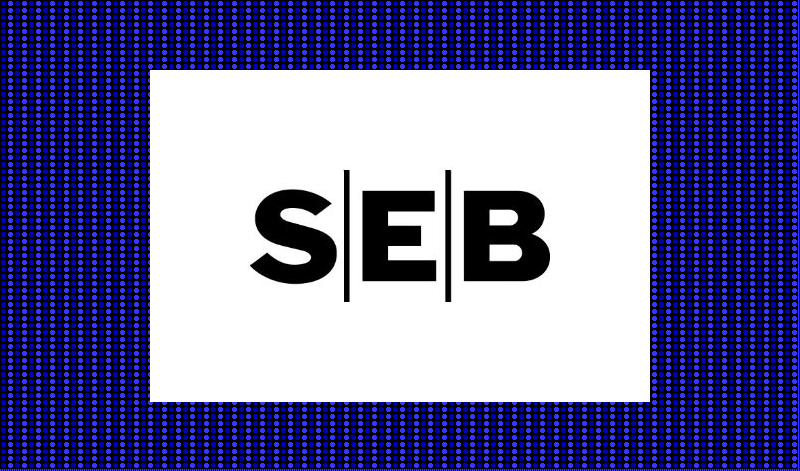
The latest weekly report from the US DOE showed a substantial drawdown across key petroleum categories, adding more upside potential to the fundamental picture.

Commercial crude inventories (excl. SPR) fell by 5.8 million barrels, bringing total inventories down to 415.1 million barrels. Now sitting 11% below the five-year seasonal norm and placed in the lowest 2015-2022 range (see picture below).
Product inventories also tightened further last week. Gasoline inventories declined by 2.1 million barrels, with reductions seen in both finished gasoline and blending components. Current gasoline levels are about 3% below the five-year average for this time of year.
Among products, the most notable move came in diesel, where inventories dropped by almost 4.1 million barrels, deepening the deficit to around 20% below seasonal norms – continuing to underscore the persistent supply tightness in diesel markets.
The only area of inventory growth was in propane/propylene, which posted a significant 5.1-million-barrel build and now stands 9% above the five-year average.
Total commercial petroleum inventories (crude plus refined products) declined by 4.2 million barrels on the week, reinforcing the overall tightening of US crude and products.
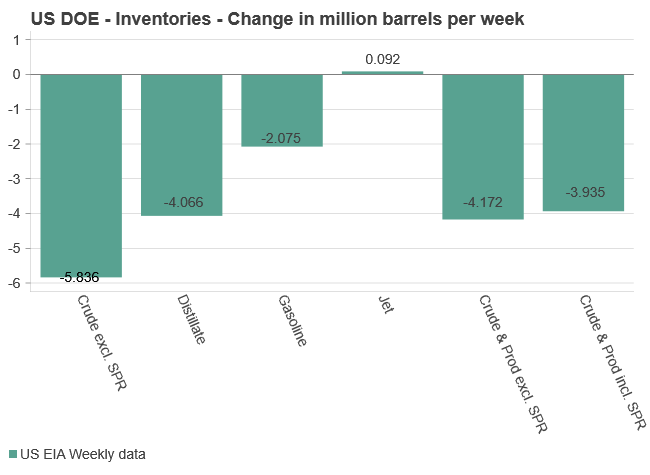
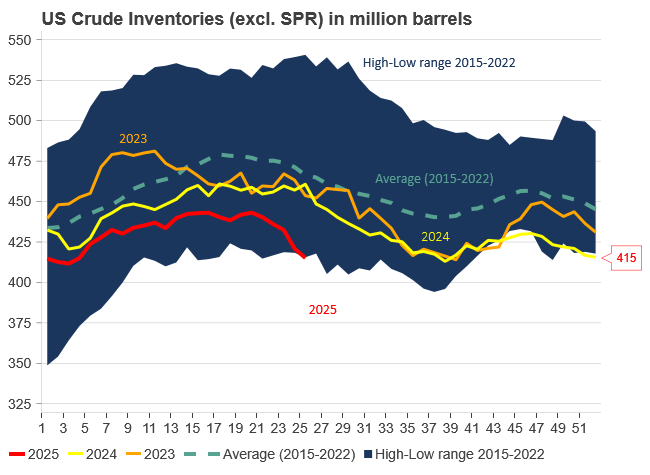
Analys
Bombs to ”ceasefire” in hours – Brent below $70

A classic case of “buy the rumor, sell the news” played out in oil markets, as Brent crude has dropped sharply – down nearly USD 10 per barrel since yesterday evening – following Iran’s retaliatory strike on a U.S. air base in Qatar. The immediate reaction was: “That was it?” The strike followed a carefully calibrated, non-escalatory playbook, avoiding direct threats to energy infrastructure or disruption of shipping through the Strait of Hormuz – thus calming worst-case fears.

After Monday morning’s sharp spike to USD 81.4 per barrel, triggered by the U.S. bombing of Iranian nuclear facilities, oil prices drifted sideways in anticipation of a potential Iranian response. That response came with advance warning and caused limited physical damage. Early this morning, both the U.S. President and Iranian state media announced a ceasefire, effectively placing a lid on the immediate conflict risk – at least for now.
As a result, Brent crude has now fallen by a total of USD 12 from Monday’s peak, currently trading around USD 69 per barrel.
Looking beyond geopolitics, the market will now shift its focus to the upcoming OPEC+ meeting in early July. Saudi Arabia’s decision to increase output earlier this year – despite falling prices – has drawn renewed attention considering recent developments. Some suggest this was a response to U.S. pressure to offset potential Iranian supply losses.
However, consensus is that the move was driven more by internal OPEC+ dynamics. After years of curbing production to support prices, Riyadh had grown frustrated with quota-busting by several members (notably Kazakhstan). With Saudi Arabia cutting up to 2 million barrels per day – roughly 2% of global supply – returns were diminishing, and the risk of losing market share was rising. The production increase is widely seen as an effort to reassert leadership and restore discipline within the group.
That said, the FT recently stated that, the Saudis remain wary of past missteps. In 2018, Riyadh ramped up output at Trump’s request ahead of Iran sanctions, only to see prices collapse when the U.S. granted broad waivers – triggering oversupply. Officials have reportedly made it clear they don’t intend to repeat that mistake.
The recent visit by President Trump to Saudi Arabia, which included agreements on AI, defense, and nuclear cooperation, suggests a broader strategic alignment. This has fueled speculation about a quiet “pump-for-politics” deal behind recent production moves.
Looking ahead, oil prices have now retraced the entire rally sparked by the June 13 Israel–Iran escalation. This retreat provides more political and policy space for both the U.S. and Saudi Arabia. Specifically, it makes it easier for Riyadh to scale back its three recent production hikes of 411,000 barrels each, potentially returning to more moderate increases of 137,000 barrels for August and September.
In short: with no major loss of Iranian supply to the market, OPEC+ – led by Saudi Arabia – no longer needs to compensate for a disruption that hasn’t materialized, especially not to please the U.S. at the cost of its own market strategy. As the Saudis themselves have signaled, they are unlikely to repeat previous mistakes.
Conclusion: With Brent now in the high USD 60s, buying oil looks fundamentally justified. The geopolitical premium has deflated, but tensions between Israel and Iran remain unresolved – and the risk of missteps and renewed escalation still lingers. In fact, even this morning, reports have emerged of renewed missile fire despite the declared “truce.” The path forward may be calmer – but it is far from stable.
Analys
A muted price reaction. Market looks relaxed, but it is still on edge waiting for what Iran will do

Brent crossed the 80-line this morning but quickly fell back assigning limited probability for Iran choosing to close the Strait of Hormuz. Brent traded in a range of USD 70.56 – 79.04/b last week as the market fluctuated between ”Iran wants a deal” and ”US is about to attack Iran”. At the end of the week though, Donald Trump managed to convince markets (and probably also Iran) that he would make a decision within two weeks. I.e. no imminent attack. Previously when when he has talked about ”making a decision within two weeks” he has often ended up doing nothing in the end. The oil market relaxed as a result and the week ended at USD 77.01/b which is just USD 6/b above the year to date average of USD 71/b.

Brent jumped to USD 81.4/b this morning, the highest since mid-January, but then quickly fell back to a current price of USD 78.2/b which is only up 1.5% versus the close on Friday. As such the market is pricing a fairly low probability that Iran will actually close the Strait of Hormuz. Probably because it will hurt Iranian oil exports as well as the global oil market.
It was however all smoke and mirrors. Deception. The US attacked Iran on Saturday. The attack involved 125 warplanes, submarines and surface warships and 14 bunker buster bombs were dropped on Iranian nuclear sites including Fordow, Natanz and Isfahan. In response the Iranian Parliament voted in support of closing the Strait of Hormuz where some 17 mb of crude and products is transported to the global market every day plus significant volumes of LNG. This is however merely an advise to the Supreme leader Ayatollah Ali Khamenei and the Supreme National Security Council which sits with the final and actual decision.
No supply of oil is lost yet. It is about the risk of Iran closing the Strait of Hormuz or not. So far not a single drop of oil supply has been lost to the global market. The price at the moment is all about the assessed risk of loss of supply. Will Iran choose to choke of the Strait of Hormuz or not? That is the big question. It would be painful for US consumers, for Donald Trump’s voter base, for the global economy but also for Iran and its population which relies on oil exports and income from selling oil out of that Strait as well. As such it is not a no-brainer choice for Iran to close the Strait for oil exports. And looking at the il price this morning it is clear that the oil market doesn’t assign a very high probability of it happening. It is however probably well within the capability of Iran to close the Strait off with rockets, mines, air-drones and possibly sea-drones. Just look at how Ukraine has been able to control and damage the Russian Black Sea fleet.
What to do about the highly enriched uranium which has gone missing? While the US and Israel can celebrate their destruction of Iranian nuclear facilities they are also scratching their heads over what to do with the lost Iranian nuclear material. Iran had 408 kg of highly enriched uranium (IAEA). Almost weapons grade. Enough for some 10 nuclear warheads. It seems to have been transported out of Fordow before the attack this weekend.
The market is still on edge. USD 80-something/b seems sensible while we wait. The oil market reaction to this weekend’s events is very muted so far. The market is still on edge awaiting what Iran will do. Because Iran will do something. But what and when? An oil price of 80-something seems like a sensible level until something do happen.
-

 Nyheter4 veckor sedan
Nyheter4 veckor sedanUppgången i oljepriset planade ut under helgen
-

 Nyheter3 veckor sedan
Nyheter3 veckor sedanMahvie Minerals växlar spår – satsar fullt ut på guld
-

 Nyheter4 veckor sedan
Nyheter4 veckor sedanLåga elpriser i sommar – men mellersta Sverige får en ökning
-

 Nyheter2 veckor sedan
Nyheter2 veckor sedanOljan, guldet och marknadens oroande tystnad
-

 Analys4 veckor sedan
Analys4 veckor sedanVery relaxed at USD 75/b. Risk barometer will likely fluctuate to higher levels with Brent into the 80ies or higher coming 2-3 weeks
-

 Nyheter2 veckor sedan
Nyheter2 veckor sedanJonas Lindvall är tillbaka med ett nytt oljebolag, Perthro, som ska börsnoteras
-

 Analys3 veckor sedan
Analys3 veckor sedanA muted price reaction. Market looks relaxed, but it is still on edge waiting for what Iran will do
-

 Nyheter2 veckor sedan
Nyheter2 veckor sedanDomstolen ger klartecken till Lappland Guldprospektering


